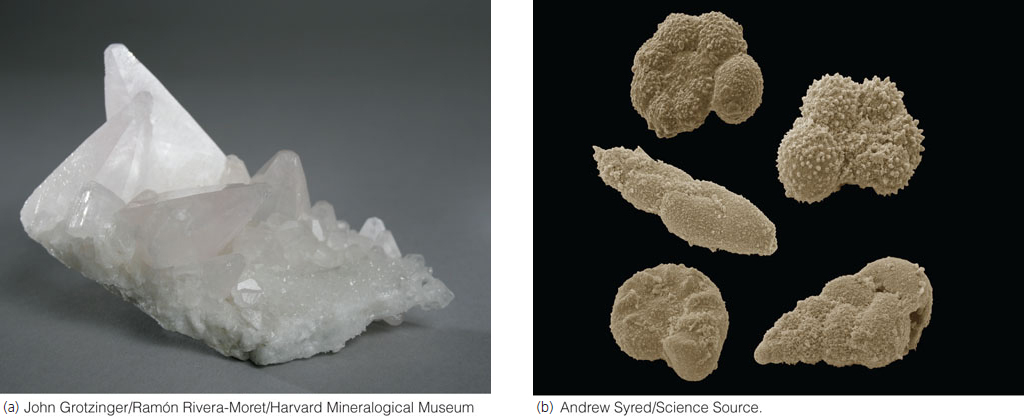What are Minerals?
Minerals are the building blocks of rocks. Mineralogy is the branch of geology that studies the composition, structure, appearance, stability, occurrence, and associations of minerals. With the proper tools, most rocks can be separated into their constituent minerals. A few kinds of rocks, such as limestone, are made up primarily of a single mineral (in this case, calcite). Other rocks, such as granite, are made up of several different minerals. To identify and classify the many kinds of rocks that compose Earth and understand how they are formed, we must know how minerals are formed.
Geologists define a mineral as a naturally occurring, solid crystalline substance, usually inorganic, with a specific chemical composition. Minerals are homogeneous: they cannot be divided mechanically into smaller components.
Let’s examine each part of our definition of a mineral in a little more detail.
Naturally occurring: To qualify as a mineral, a substance must be found in nature. The diamonds mined in South Africa, for example, are minerals. The synthetic versions produced in industrial laboratories are not minerals, nor are the thousands of laboratory products invented by chemists.
Solid crystalline substance: Minerals are solid substances—they are neither liquids nor gases. When we say that a mineral is crystalline, we mean that the tiny particles of matter, or atoms, that compose it are arranged in an orderly, repeating, three-dimensional array. Solid materials that have no such orderly arrangement are referred to as glassy or amorphous (without form) and are not conventionally called minerals. Windowpane glass is amorphous, as are some natural glasses formed during volcanic eruptions. Later in this chapter, we will explore in detail the process by which crystalline materials form.
Usually inorganic: Minerals are defined as inorganic substances and so exclude the organic materials that make up plant and animal bodies. Organic matter is composed of organic carbon, the form of carbon found in all organisms, living or dead. Decaying vegetation in a wetland may be geologically transformed into coal, which is also made of organic carbon, but although it is found in naturally occurring deposits, coal is not considered a mineral. Many minerals, however, are secreted by organisms. One such mineral, calcite (Figure 3.1), which forms the shells of oysters and many other marine organisms, contains inorganic carbon. These shells accumulate on the seafloor, where they may be geologically transformed into limestone. The calcite of these shells fits the definition of a mineral because it is inorganic and crystalline.

With a specific chemical composition: The key to understanding the composition of Earth materials lies in knowing how the chemical elements are organized into minerals. What makes each mineral unique is its chemical composition and the arrangement of its atoms in an internal structure. A mineral’s chemical composition either is fixed or varies within defined limits. The mineral quartz, for example, has a fixed ratio of two atoms of oxygen to one atom of silicon. This ratio never varies, even though quartz is found in many different kinds of rocks. Similarly, the chemical elements that make up the mineral olivine—iron, magnesium, oxygen, and silicon—always have a fixed ratio. Although the numbers of iron and magnesium atoms may vary, the sum of those two atoms in relation to the number of silicon atoms always forms a fixed ratio.
59